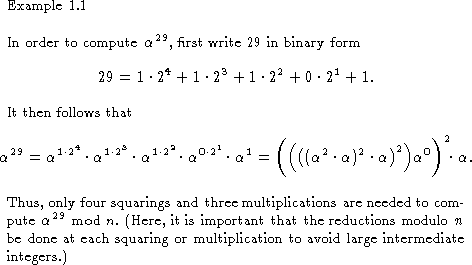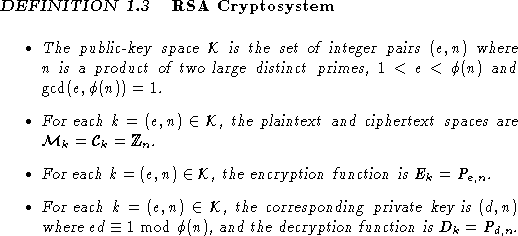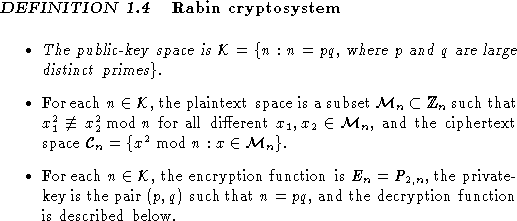The problem of distinguishing prime numbers from composite numbers and of resolving the latter into their prime factors is known to be one of the most important and useful in arithmetic. It has engaged the industry and wisdom of ancient and modern geometers to such an extent that it would be superfluous to discuss the problem at lengthGauss wrote these words some 175 years before primality testing and the integer factorization problem were applied to modern day cryptography, so as important as they were in Gauss' day, they are even more important today.Further, the dignity of the science itself seems to require solution of a problem so elegant and so celebrated.
It is clear from his words that Gauss realized that primality testing was a different problem from that of integer factorization, and since his time, significant progress has been made on both of these problems. For example, there is an efficient probabilistic algorithm called the Rabin-Miller test (see [3, ]) which can recognize a composite number of say 1,000 digits without ever factoring that number, and the primality of a number can also be determined efficiently [1, ]. There have also been developed over the years much improved factoring algorithms [13], but despite this progress, factoring a general composite number with as few as say 200 digits is still out of reach of the fastest computers using the best algorithms known today.
It is not our purpose here to delve into the theory of primality testing and integer factorization (for which we refer the reader to [13, 20] for recent developments). Instead, we simply wish to emphasize that it is easy to generate and multiply large prime numbers but it is not generally possible to factor the resulting answer in reasonable time; that is, integer multiplication appears to be a one-way function. This belief forms the basis for several public-key cryptosystems. We will discuss two of these after reviewing several ideas from modular arithmetic.
Let n be a positive integer and let ![]() denote
the ring of integers modulo n. It turns out that exponentiation in this
ring is easy; i.e., for any
denote
the ring of integers modulo n. It turns out that exponentiation in this
ring is easy; i.e., for any ![]() and positive integer e,
the computation of
and positive integer e,
the computation of ![]() can be done efficiently. We
demonstrate how this is done with an example.
can be done efficiently. We
demonstrate how this is done with an example.

The above idea can be generalized to show that ![]() can be computed
with
can be computed
with ![]() squarings and
at most
squarings and
at most ![]() multiplications, where
multiplications, where ![]() is the length of e
in its binary representation.
So, for any
is the length of e
in its binary representation.
So, for any ![]() and e>0,
and e>0,
![]() can be computed efficiently.
can be computed efficiently.
Now consider the reverse of the operation of exponentiation modulo n.
Assuming n is specified, two different problems arise: (a)
given ![]() and
and ![]() ,
find an integer x (if one exists) such that
,
find an integer x (if one exists) such that ![]() ; and
(b) given e and
; and
(b) given e and ![]() , find x (if one exists) such that
, find x (if one exists) such that
![]() .
These two problems are intrinsically different and each of them leads to
a public-key cryptosystem.
.
These two problems are intrinsically different and each of them leads to
a public-key cryptosystem.
Problem (a) is called the discrete logarithm problem modulo n and is believed hard for almost all n. (For certain values of n it is easy; e.g., when n has only small prime factors or when n is a prime but n-1 has only small prime factors.) We will discuss this problem and its relation to the ElGamal system in the next section.
Problem (b) asks for the computation of an eth root of an integer y
modulo n. This is easy when the complete factorization of n is known but
believed hard otherwise. For cryptographic purposes, the most
important case is when n is the product of two large (distinct) primes
and this is the case we shall develop here. (Our discussion can be readily
generalized to the situation where n is square-free.)
The RSA system arises when we examine this situation with ![]() and the
Rabin system comes from considering the case in which e divides
and the
Rabin system comes from considering the case in which e divides ![]() .
Here
.
Here ![]() is the familiar Euler
is the familiar Euler ![]() -function which equals
the number of integers in
-function which equals
the number of integers in ![]() that are relatively prime to n.
When n = pq with p and q distinct primes, it is given by
that are relatively prime to n.
When n = pq with p and q distinct primes, it is given by
![]() .
.
Assume then that n= pq and let e be an integer with
![]() . Then there exists an integer d such that
. Then there exists an integer d such that ![]() . Using Fermat's little theorem, it is straightforward
to show that
. Using Fermat's little theorem, it is straightforward
to show that
![]()
This means that for any ![]() ,
, ![]() is an eth root of x
modulo n; hence an eth root of x can be computed efficiently provided
d is known. Thus an important question is whether d be
computed efficiently.
is an eth root of x
modulo n; hence an eth root of x can be computed efficiently provided
d is known. Thus an important question is whether d be
computed efficiently.
The answer is yes if n can be factored but no otherwise.
To explain this statement, first assume that the complete
factorization of n into primes is known. Then ![]() can be
computed quickly. By applying the extended Euclidean algorithm [3]
to e and
can be
computed quickly. By applying the extended Euclidean algorithm [3]
to e and ![]() , it is easy to find d such that
, it is easy to find d such that
![]() . Conversely, assume that a number d
is known with
. Conversely, assume that a number d
is known with ![]() . Then
. Then ![]() is a
multiple of
is a
multiple of ![]() . By Exercise 9.3, n can be easily factored
using
. By Exercise 9.3, n can be easily factored
using ![]() . Hence computing d from e and n is equivalent
to factoring n.
Therefore, the factors of n provide a trap-door for inverting the
function
. Hence computing d from e and n is equivalent
to factoring n.
Therefore, the factors of n provide a trap-door for inverting the
function ![]() defined as
defined as
![]()
where ![]() denotes the smallest nonnegative integer
congruent to
denotes the smallest nonnegative integer
congruent to ![]() modulo n.
modulo n.
We can now describe the RSA cryptosystem, which bases its
security on the belief that the class of functions ![]() are trap-door
one-way functions.
are trap-door
one-way functions.

We also need a rule for generating a random pair of public and private
keys (e,n) and (d,n), but this is not difficult. We have mentioned that
primality testing can be done efficiently and further there are many primes with
a given number say of t digits (by the prime number theorem).
This means that one can generate a t-digit prime as follows.
Choose a random number of t digits
and test it for primality. If it is not prime, repeat the procedure until
a prime is obtained. In this way one can get a pair of primes p and q
of any desired size. Then defining n=pq and N=(p-1)(q-1), one may choose a
random integer ![]() such that
such that ![]() . For this e, it is a
simple matter to compute d with
. For this e, it is a
simple matter to compute d with ![]() . Then (e,n) is
a public key and (d,n) is the corresponding private key.
. Then (e,n) is
a public key and (d,n) is the corresponding private key.
We should point out that, even though computing d from e and n is
equivalent to factoring n, it has not been proven that inverting
![]() is equivalent to computing d or factoring n, as there may
exist some other method to compute eth roots modulo n without
factoring n or computing d. This raises the following research question.
is equivalent to computing d or factoring n, as there may
exist some other method to compute eth roots modulo n without
factoring n or computing d. This raises the following research question.
Open Problem. Given a composite integer n and a positive
integer e with ![]() , prove or disprove that
computing eth roots modulo n is equivalent to factoring n.
, prove or disprove that
computing eth roots modulo n is equivalent to factoring n.
We next consider the case in which e divides ![]() , used in the
Rabin system. Here, the function
, used in the
Rabin system. Here, the function ![]() is no longer a permutation on
is no longer a permutation on
![]() since for a given e and y, there can be several x that
map to the same y under
since for a given e and y, there can be several x that
map to the same y under ![]() . However, if e is small relative to n, say
. However, if e is small relative to n, say ![]() for some constant c, then it can be proved that finding the
inverse images of y under
for some constant c, then it can be proved that finding the
inverse images of y under ![]() is equivalent to factoring n. Thus, if
e is (say) one of 2, 3, 5, 6, 7, then
is equivalent to factoring n. Thus, if
e is (say) one of 2, 3, 5, 6, 7, then ![]() is a candidate trap-door
one-way function where the factors of n again provide the trap-door for
inverting
is a candidate trap-door
one-way function where the factors of n again provide the trap-door for
inverting ![]() . Such trap-door one-way functions can be used to build up
public-key cryptosystems; indeed, the Rabin system uses only the function
. Such trap-door one-way functions can be used to build up
public-key cryptosystems; indeed, the Rabin system uses only the function
![]() and is described as follows.
and is described as follows.

To decrypt a ciphertext under the Rabin system, we need to describe how to
compute
square roots modulo n given the factors of n.
The idea is to compute square roots modulo each prime factor of n
separately and then use the Chinese remainder theorem to combine them
to get a square root modulo n.
Suppose that ![]() has a square root modulo n.
Then c also has square roots modulo p and q.
Moreover, if r and s are some square roots of c modulo p and q,
respectively,
and if a and b are integers such that ap+bq=1, then it is easy to check
that
has a square root modulo n.
Then c also has square roots modulo p and q.
Moreover, if r and s are some square roots of c modulo p and q,
respectively,
and if a and b are integers such that ap+bq=1, then it is easy to check
that ![]()
is a square root of c modulo n for any choice of + and - signs.
This gives four square roots of c.
It can be shown that c has exactly four square roots if and only if
![]() and
c has at least one square root modulo n.
To get the correct plaintext one just needs to check which of the roots is in
and
c has at least one square root modulo n.
To get the correct plaintext one just needs to check which of the roots is in ![]() .
.
It remains to show how to compute square roots modulo a prime p.
But this is also easy, especially when ![]() , for then
, for then
![]() is a square root of c whenever c is a quadratic
residue
in
is a square root of c whenever c is a quadratic
residue
in ![]() : that is,
: that is, ![]() for some
for some ![]() .
If p is congruent to 1 modulo 4,
square roots modulo p can also be computed efficiently but will not be
described
here (see [3, 5] for details).
Hence computing square roots modulo n=pq is easy when p and q
are known.
.
If p is congruent to 1 modulo 4,
square roots modulo p can also be computed efficiently but will not be
described
here (see [3, 5] for details).
Hence computing square roots modulo n=pq is easy when p and q
are known.
We conclude this section by showing that if one can compute square roots modulo
n then
one can actually factor n; that is, we show that computing square roots modulo
n
is equivalent to factoring n.
This also provides a nice example illustrating the power of randomness in
computing.
Suppose that there is an algorithm ![]() which, when presented a
quadratic
residue
which, when presented a
quadratic
residue ![]() , outputs a square root of x in
, outputs a square root of x in ![]() , denoted by
, denoted by
![]() . (One may think of
. (One may think of ![]() as an algorithm, a black box, or an
oracle.)
Then n can be factored by the following simple algorithm.
First, pick a nonzero element
as an algorithm, a black box, or an
oracle.)
Then n can be factored by the following simple algorithm.
First, pick a nonzero element ![]() uniform randomly and
compute
uniform randomly and
compute ![]() . Next, input x to
. Next, input x to ![]() and get
and get ![]() .
Then compute
.
Then compute ![]() .
It can be shown that for each run of the algorithm,
the computed number h is a proper factor of n
with probability at least 1/2.
If the algorithm is run t times, then the probability
of getting a factor of n is at least
.
It can be shown that for each run of the algorithm,
the computed number h is a proper factor of n
with probability at least 1/2.
If the algorithm is run t times, then the probability
of getting a factor of n is at least ![]() . Thus for t=10,
the chance of finding a factor of n is over
. Thus for t=10,
the chance of finding a factor of n is over ![]() ! Therefore n can be
factored quickly.
! Therefore n can be
factored quickly.
As we have indicated, breaking the Rabin system is equivalent to factoring integers. This is the first example of a public-key cryptosystem with provable security against a passive adversary who can only eavesdrop. Compared to the RSA system, the encryption in Rabin system is more efficient (only one square), and the decryption costs approximately the same as in RSA. However, the same proof above shows that the Rabin system is totally insecure against an active adversary who can mount a chosen ciphertext attack. Under this attack, an adversary chooses some (possibly many) ciphertexts and asks for the corresponding plaintexts, then deduces from them the secret key. The reader should be able to see why this attack works against the Rabin system. Because of this, the Rabin system is not used in practice.